China Is Building a Robot Army of Model Workers
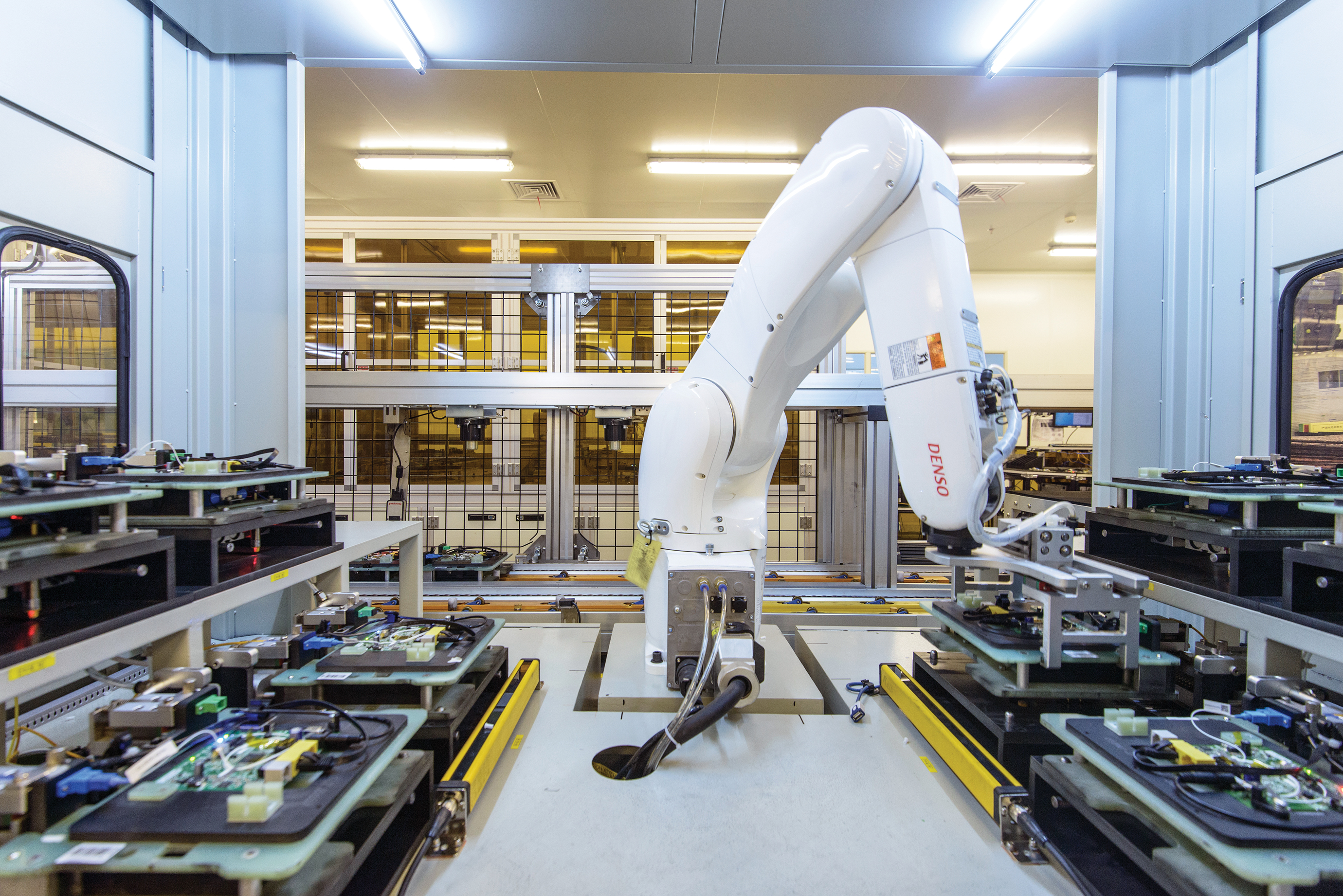
Inside a large, windowless room in an electronics factory in south Shanghai, about 15 workers are eyeing a small robot arm with frustration. Near the end of the production line where optical networking equipment is being packed into boxes for shipping, the robot sits motionless.
“The system is down,” explains Nie Juan, a woman in her early 20s who is responsible for quality control. Her team has been testing the robot for the past week. The machine is meant to place stickers on the boxes containing new routers, and it seemed to have mastered the task quite nicely. But then it suddenly stopped working. “The robot does save labor,” Nie tells me, her brow furrowed, “but it is difficult to maintain.”
The hitch reflects a much bigger technological challenge facing China’s manufacturers today. Wages in Shanghai have more than doubled in the past seven years, and the company that owns the factory, Cambridge Industries Group, faces fierce competition from increasingly high-tech operations in Germany, Japan, and the United States. To address both of these problems, CIG wants to replace two-thirds of its 3,000 workers with machines this year. Within a few more years, it wants the operation to be almost entirely automated, creating a so-called “dark factory.” The idea is that with so few people around, you could switch the lights off and leave the place to the machines.
But as the idle robot arm on CIG’s packaging line suggests, replacing humans with machines is not an easy task. Most industrial robots have to be extensively programmed, and they will perform a job properly only if everything is positioned just so. Much of the production work done in Chinese factories requires dexterity, flexibility, and common sense. If a box comes down the line at an odd angle, for instance, a worker has to adjust his or her hand before affixing the label. A few hours later, the same worker might be tasked with affixing a new label to a different kind of box. And the following day he or she might be moved to another part of the line entirely.
Despite the huge challenges, countless manufacturers in China are planning to transform their production processes using robotics and automation at an unprecedented scale. In some ways, they don’t really have a choice. Human labor in China is no longer as cheap as it once was, especially compared with labor in rival manufacturing hubs growing quickly in Asia. In Vietnam, Thailand, and Indonesia, factory wages can be less than a third of what they are in the urban centers of China. One solution, many manufacturers—and government officials—believe, is to replace human workers with machines.
The results of this effort will be felt globally. Almost a quarter of the world’s products are made in China today. If China can use robots and other advanced technologies to retool types of production never before automated, that might turn the country, now the world’s sweatshop, into a hub of high-tech innovation. Less clear, however, is how that would affect the millions of workers recruited to China’s booming factories.
There are still plenty of workers around now as I tour CIG’s factory with the company’s CEO, Gerald Wong, a compact man who earned degrees from MIT in the 1980s. We watch a team of people performing delicate soldering on circuit boards, and another group clicking circuit boards into plastic casings. Wong stops to demonstrate a task that is proving especially hard to automate: attaching a flexible wire to a circuit board. “It’s always curled differently,” he says with annoyance.
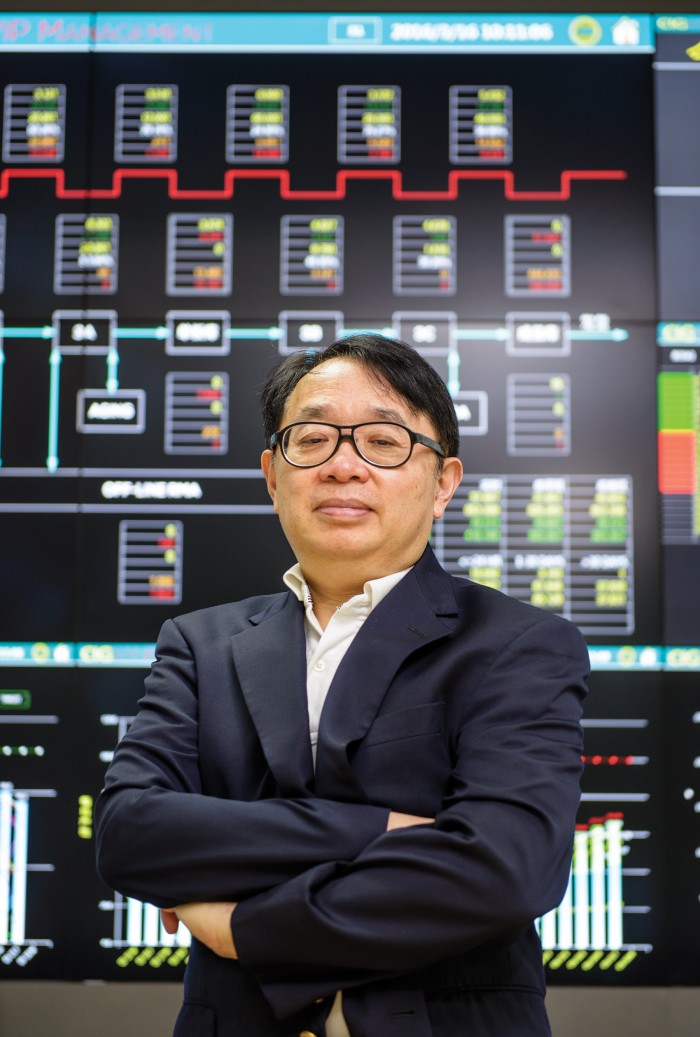
But there are some impressive examples of automation creeping through Wong’s factory, too. As we walk by a row of machines that stamp chips into circuit boards, a wheeled robot roughly the size of a mini-fridge rolls by ferrying components in the other direction. Wong steps in front of the machine to show me how it will detect him and stop. In another part of the factory, we watch a robot arm grab finished circuit boards from a conveyor belt and place them into a machine that automatically checks their software. Wong explains that his company is testing a robot that does the soldering work we saw earlier more quickly and reliably than a person.
After we finish the tour, he says, “It is very clear in China: people will either go into automation or they will go out of the manufacturing business.”
Automate or bust
China’s economic miracle is directly attributable to its manufacturing industry. Approximately 100 million people are employed in manufacturing in China (in the U.S., the number is around 12 million), and the sector accounts for almost 36 percent of China’s gross domestic product. During the last few decades, manufacturing empires were forged around the Yangtze River Delta, Bohai Bay outside Beijing, and the Pearl River Delta in the south. Millions of low-skilled migrant workers found employment in gigantic factories, producing an unimaginable range of products, from socks to servers. China accounted for just 3 percent of global manufacturing output in 1990. Today it produces almost a quarter, including 80 percent of all air conditioners, 71 percent of all mobile phones, and 63 percent of the world’s shoes. For consumers around the world, this manufacturing boom has meant many low-cost products, from affordable iPhones to flat-screen televisions.
In recent years, though, China’s manufacturing engine has started to stall. Wages have increased at a crippling 12 percent per year on average since 2001. Chinese exports fell last year for the first time since the financial crisis of 2009. And toward the end of 2015 the Caixin Purchasing Managers’ Index, a widely used indicator of manufacturing activity, showed that the sector had contracted for the 10th month in a row. Just as China’s manufacturing boom fed the global economy, the prospect of its decline has already started to spook the world’s financial markets.
Within a few years, CIG plans to have a largely automated operation—what’s sometimes called a “dark factory.”
Automation appears to offer an enticing technological solution. China already imports a huge number of industrial robots, but the country lags far behind competitors in the ratio of robots to workers. In South Korea, for instance, there are 478 robots per 10,000 workers; in Japan the figure is 315; in Germany, 292; in the United States it is 164. In China that number is only 36.
The Chinese government is keen to change this. On March 16, officials approved the latest Five Year Plan for China’s economy, which is reported to include an initiative that will make billions of yuan available for manufacturers to upgrade to technologies including advanced machinery and robots. The government also plans to create dozens of innovation centers across the country to showcase advanced manufacturing technologies. Some regional authorities in China have been especially bold in their own efforts. Last year the government of Guangdong, a province that contains many large manufacturing operations, promised to spend $150 billion equipping factories with industrial robots and creating two new centers dedicated to advanced automation.
The goal is to overtake Germany, Japan, and the United States in terms of manufacturing sophistication by 2049, the 100th anniversary of the founding of the People’s Republic of China. To make that happen, the government needs Chinese manufacturers to adopt robots by the millions. It also wants Chinese companies to start producing more of these robots.
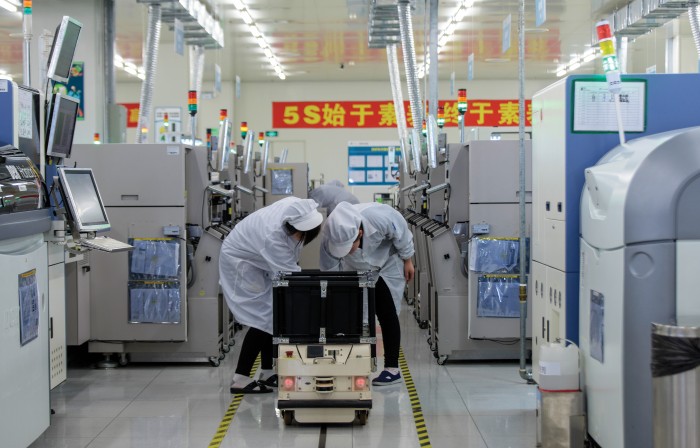
The hope is that this will create a virtuous cycle, helping to birth a new high-tech industry and inspiring innovations that could spill over from manufacturing into other sectors and products.
Introducing hordes of robot workers is hardly something that can be done overnight, however. That much is clear from the struggles faced by Foxconn, a $130 billion Taiwanese manufacturer famous for employing hundreds of thousands of workers in city-size factories—and for making, among other products, Apple’s iPhones. In 2011, Foxconn’s founder and CEO, Terry Gou, said he expected to have a million robots in his company’s plants by 2014. Three years later, the effort had proved more challenging than expected, and just a few tens of thousands of robots had been deployed.
The transition to robot workers may upend Chinese society, since so many people work in manufacturing.
Despite the challenges, Day Chia-peng, general manager of Foxconn’s automation technology development committee, says the company is automating a growing number of tasks on its lines. These include the manufacture of displays and printed circuit boards, although processes that involve bending or snapping components into place still pose challenges. The company is even exploring ways that products themselves can be redesigned to make automated manufacturing easier. And it recently said it will sell some of the robots it has developed in-house to other manufacturers.
The transition from human to robot workers may upend Chinese society. Some displaced factory workers could find employment in the service sector, but not all of the 100 million now employed in factories will find such jobs a good match. So a sudden shift toward robots and automation could cause economic hardship and social unrest. “You can make the argument that robotic technology is the way to save manufacturing in China,” says Yasheng Huang, a professor at MIT’s Sloan School of Management. “But China also has a huge labor force. What are you going to do with them?”
Dancing bots
A few days before visiting CIG, I went to China’s first major robotics event, the World Robot Conference, held inside a vast exhibition hall located within Beijing’s Olympic Park. The city was in the grip of an unusually cold spell, and producing the electricity to meet its heating needs had resulted in lung-searing air pollution from nearby coal power plants. But the snow and smog had done nothing to deter hundreds of researchers and companies, and thousands of attendees, from coming to the event.
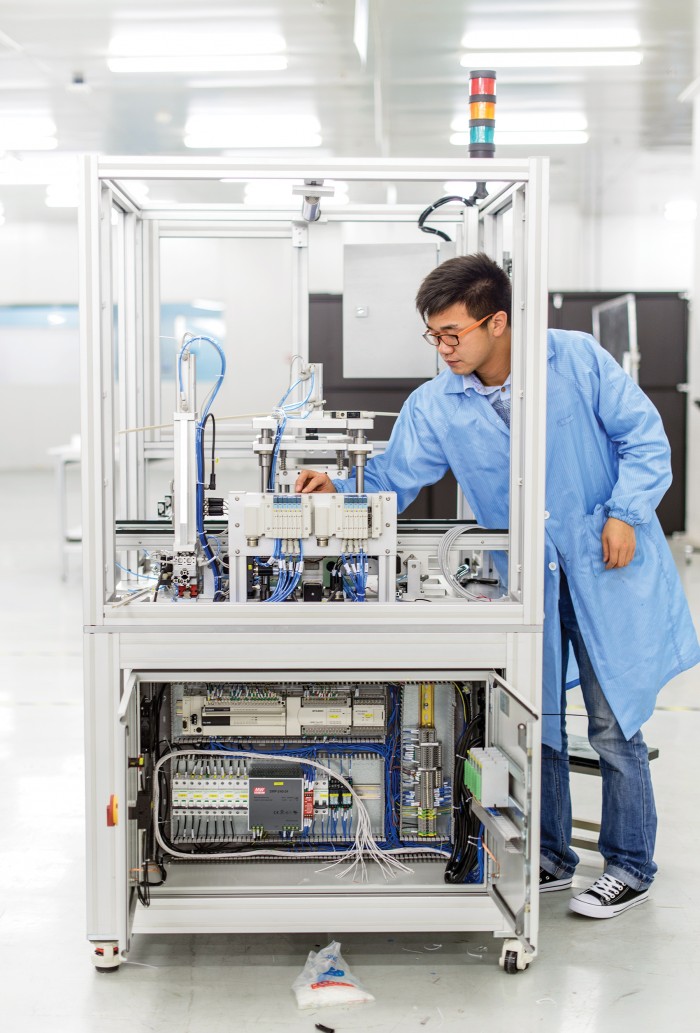
First came a theatrical opening ceremony, during which a huge video wall showed innovations from China’s ancient history spliced, somewhat oddly, with clips of robots from science fiction movies. The guest list included several high-ranking Chinese politicians. Li Yuanchao, China’s vice president, read messages of congratulations from President Xi Jinping and Premier Li Keqiang. The vice president said that investing in robotics research would not only feed the country’s manufacturing industry but encourage greater domestic innovation.
After watching several talks, I wandered past endless demos set up by robot companies and research institutes. I watched as an enormous industrial robot fitted with a fork-like appendage went through some sort of routine factory work at terrifying speed. Other demos were more whimsical, like a small industrial machine performing a mesmerizing rendition of a traditional Chinese dragon dance (in full costume), and a mobile robot equipped with two racquets playing badminton with excited attendees. A humanoid robot with flashing eyes was carrying a small automated vacuum cleaner around on a tray.
It was also possible to grasp just how ambitious China will be in trying to replace human workers in its factories. HIT Robot Group, a company affiliated with one of the country’s foremost technical universities, Harbin Institute of Technology, had mocked up a battery production line that itself seemed like one giant robot. Robotic vehicles ferried components between various manufacturing machines. The only spots for humans were inside a control room in the center and on a line where especially fiddly manual work needed to be done. I later learned that HIT estimates the new factory could reduce human labor by as much as 85 percent.
But it was also evident that as a country with a history of seemingly endless cheap labor, China had to date been outpaced in the robot revolution. Rethink Robotics, a Boston-based company, was showing off a pair of flexible and intelligent industrial machines. Unlike conventional industrial robots, these products, called Baxter and Sawyer, require very little programming, and they are equipped with sensors that allow them to recognize objects and avoid hitting people. They also cost between $20,000 and $30,000 instead of the hundreds of thousands typical of an industrial robot. Speaking to me after the event, Rethink founder and robotics pioneer Rodney Brooks said that China represents a huge potential market for his company, which recently opened offices in Shanghai. Chinese robot makers are likely to start making more flexible and intelligent robots, too. But for now their products lag behind those of Western manufacturers.
“A game we often play when we go to a trade show in the Far East is we go and see the industrial robots from little companies and say, ‘Oh, that’s a copy of that, and that’s a copy of that,’” Brooks said. It will, he suggested, take time for China’s robotics companies to catch up.
Reinvented in China
To see for myself how far China’s researchers have to go, I visited Shanghai Jiao Tong University, one of the country’s most prestigious institutions and home to China’s oldest academic robotics lab, founded in 1979. I found myself on a lush and sprawling campus in a quiet suburb in south Shanghai, surrounded by students cycling around on squeaky bicycles. There, I found a modern-looking building that housed the robotics lab.
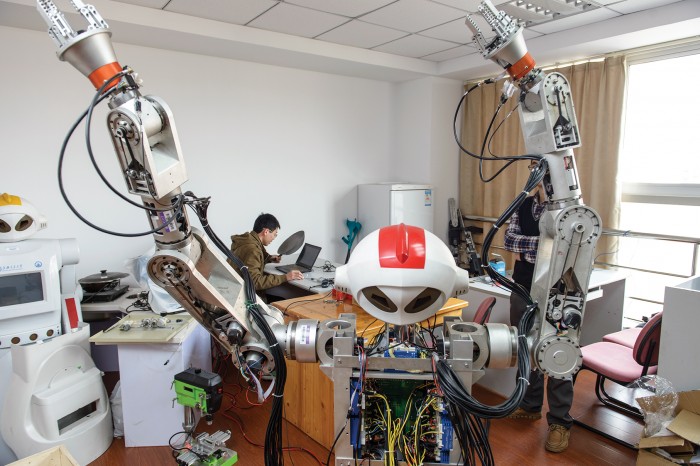

Zhu Xiangyang, a professor in his late 40s with thin glasses and a fleece sweater-vest, welcomed me to his office with tea and an irrepressible smile. The lab has a few dozen professors and research scientists and more than 100 doctoral and master’s students, and Zhu is justifiably proud of its research. In one room was a brain-controlled robotic wheelchair, operated by means of an electroencephalogram cap worn by a graduate student. A video showed a cyborg cockroach fitted with a wireless implant that connected to its peripheral nervous system and made it possible to control the creature’s movements from a computer. In another room, a researcher demonstrated snakelike and soft-bodied robots capable of reaching or crawling through narrow spaces. Inside a garage, a prototype self-driving car, not unlike one of Google’s, is being developed in collaboration with a Chinese carmaker called Chery.
“More and more, we need to get into more advanced robots. That can help make a dark factory.”
Despite the impressive research projects at places like Jiao Tong, I kept wondering just how China will fulfill its manufacturing ambitions. Kai Yu is the founder of a startup called Horizon Robotics and was previously the head of an AI-focused research lab set up by Baidu, China’s dominant Internet company. Within the Baidu lab, Yu and colleagues were focused on a field of AI called deep learning, which involves training large simulated neural networks to recognize patterns in data. Researchers are now starting to explore how machine learning might make the next generation of industrial robots even smarter and more flexible. “In the future, what I see is China being more creative [in robotics],” Yu told me. “Original design, original ideas, but also some of the fundamental technologies, like deep learning, neural networks, artificial intelligence.”
Yu believes that the AI techniques developed by China’s big Internet companies for search, e-commerce, and other purposes could be applied to robots. “China has a very good opportunity to catch up,” he said. “The skills they have learned in the last five years can be transferred to making intelligent machines.”
When I later toured CIG’s factory, it wasn’t too hard to imagine how such advances could start feeding into Wong’s efforts to automate his operation. For one thing, a robot capable of learning and adapting presumably wouldn’t be baffled by a misaligned box that needs labeling.
After the tour, Wong took me through a PowerPoint presentation that laid out the company’s plan for the next few years, and then the conversation turned to intelligent robotics. “We’re going to use standard robots at first,” Wong said. “But then we’re going to use more advanced ones. More and more, we need to get into more advanced robotics. That can help make a dark factory.”
Given the economic imperative, the government’s determination, and the country’s growing technological sophistication, it seems very likely that manufacturing companies across China will automate successfully and that the country will become a leader in the technologies of advanced automation.
And yet it’s strange to think about the changes in store for Chinese manufacturing workers. At one point during our tour we had passed a group of about 20 people taking an afternoon break. Everyone was apparently snoozing, heads rested on arms folded in front of them. That’s hardly something a robot needs to do. But I couldn’t help wondering what will happen to these workers once robots have taken their jobs. Wong says they will most likely return to their hometowns and find employment there, on a farm or perhaps in a shop or restaurant. That may be so, but for some it won’t be so simple.
A week after leaving China, I received an e-mail from Wong with some more information about his plans, along with a characteristically bold promise. “Stay in touch,” he wrote. “We will make the dark factory happen.”
Deep Dive
Artificial intelligence
Large language models can do jaw-dropping things. But nobody knows exactly why.
And that's a problem. Figuring it out is one of the biggest scientific puzzles of our time and a crucial step towards controlling more powerful future models.
Google DeepMind’s new generative model makes Super Mario–like games from scratch
Genie learns how to control games by watching hours and hours of video. It could help train next-gen robots too.
What’s next for generative video
OpenAI's Sora has raised the bar for AI moviemaking. Here are four things to bear in mind as we wrap our heads around what's coming.
Stay connected
Get the latest updates from
MIT Technology Review
Discover special offers, top stories, upcoming events, and more.